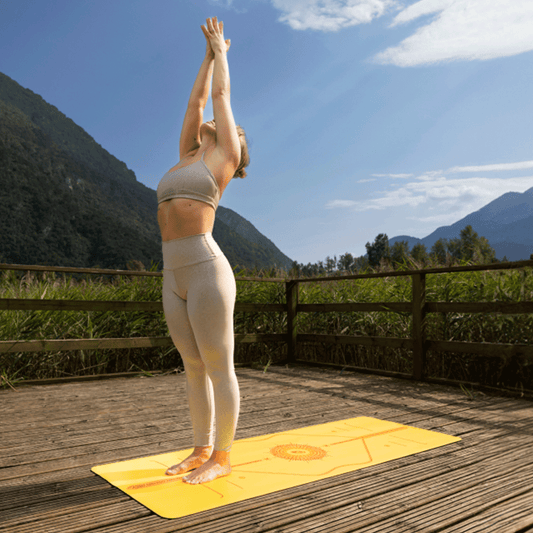When you glance around a yoga studio during a vinyasa class, next to almost every mat you’ll likely see a bottle of water just waiting to be kicked over by a particularly energetic flip dog. Staying hydrated during vigorous exercise is important, but it’s just as important to put some thought into the way that you carry around your water, and there can be no doubt that using a refillable container is way more eco-friendly than single-use bottles.
While there are some very legitimate health and safety reasons for buying bottled water, it’s most often purchased for convenience. That’s a luxury that’s hard to justify in the face of the overwhelming evidence about the negative environmental impact of plastic bottles, both before and after that H2O touches your lips, because the production and disposal of all those bottles is a big problem for our planet.
The Bottles
Single-use plastic water bottles are most often made from PET (polyethylene terephthalate), a petroleum product. The manufacture of these bottles uses crude oil, water, and energy, all of which could be put to better use elsewhere. When you buy a bottle of water, just a small fraction of the cost is the water itself. You’re also paying for the bottles and caps (plastic), packaging (paper, more plastic) and transportation (much more energy) around the planet.
What About Recycling?
Companies that produce bottled water often behave as if they have an environmental pass because PET bottles are recyclable. But there’s a big difference between recyclable (in theory) and recycled (in actuality). In Europe, about 50% of plastic bottles are recycled, which is considered a good rate. In the United States, the rate is more like 15-30%.
These low rates reflect both a lack of access to recycling programmes and the way that bottled water is used as a grab-and-go product, consumed and then quickly tossed into the nearest bin, from which they end up in landfills by the millions of tons. Bottles that don’t go into landfills often make their way to the ocean, where they may join one of the Earth’s five massive garbage gyres or break down and be consumed by marine life, entering the food chain.
While there are many amazing and important uses of modern plastics for all kinds of products (and increasingly ingenious ways of making them more eco-friendly), bottled water stands out as particularly egregious because what it’s selling us is almost universally available at a much lower cost to the planet, as well as your wallet.
What About Glass?
You may be wondering if glass bottles are a better choice. Glass recycling is closer to being a ‘closed loop’, meaning that glass is more readily turned back into usable glass, while plastic is usually downcycled into lower quality products. Glass manufacturing also requires less energy and water than plastic and glass is more inert, so it doesn’t affect the taste or composition of its contents.
Glass does have one big downside, however: it is heavy. This has a big effect on the amount of energy it takes to transport glass bottles filled with water and glass waste after use. And, don’t forget, the water in those bottles still has to come from somewhere.
The Water
So, where does all that water come from? Sometimes it comes from the Swiss Alps, sometimes a Melanesian island, sometimes a natural spring in Maine, and sometimes from a plain old tap. If you live in the Swiss Alps or Melanesia or Maine, it’s logical to drink water from there. If you don’t, it really isn’t.
The water resources in these regions are not unlimited, nor does it make sense to ship them clear across the planet to be sold as health tonics. On the other hand, the words ‘public water source’, or ‘municipal source’, which appear on the labels of several major bottled water brands, indicate that you’ve purchased filtered tap water.
Is Tap Water Clean?
So, what about the cleanliness of tap water? In light of the ongoing water crises in Flint, Michigan, and elsewhere, it’s a reasonable question. In the developed, industrialized world, safe water is considered a basic right. Tap water in these places is more frequently tested and better monitored than bottled water, though citizens must remain vigilant in the face of deregulation and eroding infrastructure. Using tap water sends a message that it is still a vital community resource.
If you are worried about what’s in your water, you can request test results from your water utility company or send a sample off for independent testing. Chlorine is often added to tap water to kill contaminants. Using a good water pitcher filter or in-sink filtration system at home can remove the chlorine, resulting in better tasting water. Filtering can also remove other toxins, including lead, which can be introduced from old pipes.
Spread the Word
In addition to quitting bottled water and recycling plastics at home, you can encourage your employer and community to do the same. At work, ask for a recycling programme. The proverbial office water cooler, while using less plastic per serving, it not without its own issues. Hard plastic is more likely to contain BPA, which can leech into the water itself. Although BPA is being phased out in most places, research shows that its common substitute, BPS, similarly effects human hormones. Offering filtered tap water costs less and is less risky.
You can also contact your local government about continuing to provide clean drinking water and implementing or improving recycling services. Public input can and does make a difference, so make your voice heard.

Caveats!
Having the choice between safe sources of drinking water is definitely a privilege. There are many places on Earth where uncontaminated water is incredibly scarce or completely unavailable. There are also circumstances in which bottled water is the best choice, such as when tap water becomes compromised or during a natural disaster. In those situations, by all means, drink bottled water. That’s what it should be for.
But in your daily, routine water use, make the choice that is best for the planet. Once you understand the environmental impact of buying bottled water, it becomes abundantly clear that it doesn’t make sense to expend so many resources on it. The best way to reduce the supply of bottled water is to reduce the demand, one person at a time. (Psst, that’s you!)




































